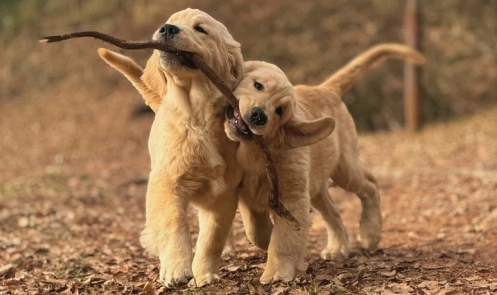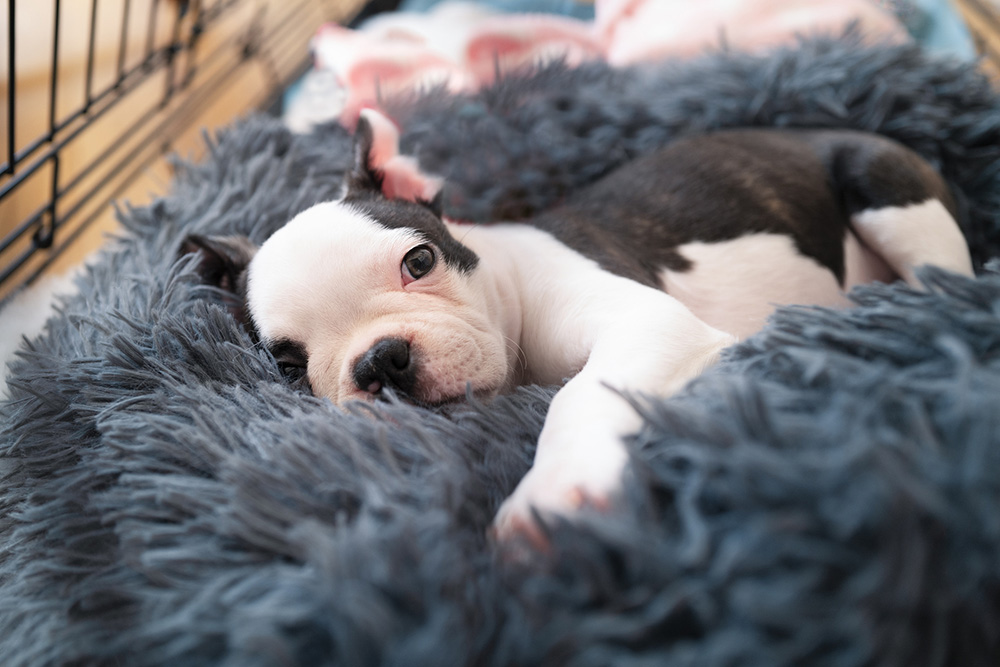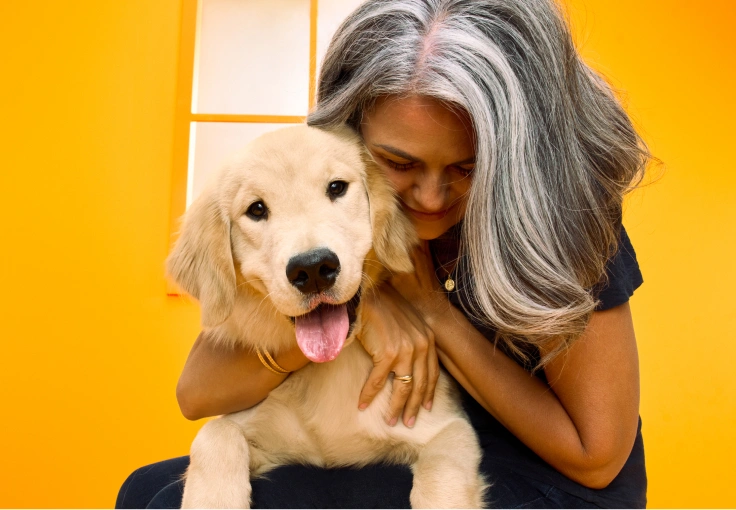Learn : Behavior & Training
How to Socialize a Puppy: A Comprehensive Guide
Socializing your puppy is an essential step towards raising a confident and well-adjusted adult dog. “Dogs are, by their very nature, social animals,” explains Fred Zorn of Fred Zorn Dog Training. “They’re meant to be in a group or pack. Interacting with others and seeing their behavior reflected in others is how they grow and learn.”
Early socialization can ensure that your puppy is comfortable in various environments, and with different people, animals and situations. A structured socialization process can also help prevent fear-based behaviors, anxiety and aggression.
In this guide, we will explore the significance of early socialization and provide actionable steps to help your puppy grow into a well-mannered canine citizen.
As Zorn puts it, “Effective training is often about respecting and understanding who and what dogs inherently are, and using it to help them learn how to best fit within our world.”
___________________________________________________________________________________________________
The Importance of Early Socialization in Puppies
Dogs that are exposed to a wide range of experiences in their formative weeks can develop into more confident and adaptable adults. Puppies who miss this critical window of socialization may struggle with anxiety, fearfulness or reactivity later in life. Proper socialization shapes a puppy’s behavior and helps them navigate the world with ease.
When to Start Puppy Socialization
Lack of early socialization can be a cause of behavioral problems in adult dogs. Fearfulness, aggression and difficulty adapting to new situations may stem from inadequate social experiences as a puppy. Introducing a puppy to diverse environments, people and animals in a controlled and positive way can help reduce the likelihood of developing problem behaviors in the future.
The first 16 weeks of a puppy’s life can be crucial for socialization. “The brain is developing so rapidly, and it’s never going to be as malleable as it is during these formative stages,” Zorn explains. “That’s why it’s important to give puppies as much exposure as possible, because it’s the easiest time for them to both accept and adapt to the world.” After this window closes, puppies become naturally more cautious of unfamiliar situations, making socialization more challenging. Ensuring your puppy has positive experiences during this time helps set a foundation for their lifelong behavior.
Components of Effective Puppy Socialization
Socialization and habituation are two key components of raising a well-adjusted puppy:
-
Socialization: Exposing a puppy to a variety of environments, people, animals and stimuli to help them become comfortable with new experiences.
-
Habituation: Teaching a puppy to ignore non-threatening stimuli, such as household noises, traffic sounds or other routine occurrences, so they do not become overly reactive to normal daily activities.
Both aspects work together to help puppies learn which situations are safe and which require their attention.
How to Socialize Your Puppy
Expose Your Puppy to People, Places and Situations
“While underexposure is an issue, you also want to be careful not to overexpose a puppy,” Zorn advises. “When there’s too much to take on, there’s too much to trust. It’s overwhelming.” Introducing a puppy to new experiences should be a gradual process. Start socialization at home in a familiar and controlled environment. Once the puppy is comfortable, slowly introduce them to new places and situations, such as quiet parks, pet-friendly stores and calm social gatherings. Positive exposure at an appropriate pace helps build confidence while preventing stress.
“It helps to understand your puppy as an individual, and what their strengths and weaknesses are, so you can help them navigate their world at a proper pace.”
Make Socializing Your Puppy a Positive Experience
To ensure socialization is effective, it should always be a positive experience. Use high-value treats (such as single-ingredient Jerky or wholesome Wafers from Nom Nom) along with praise, to reward your puppy for calm and curious behavior in new situations. Your own emotions and demeanor also play a significant role—stay calm and upbeat to help reassure your puppy that new experiences are safe and enjoyable.
Safe Interactions Pre-Vaccination
Since puppies are not fully vaccinated in their early months, take precautions when socializing them. Limit interactions to vaccinated, friendly dogs, and avoid areas with high concentrations of unknown dogs. Focus on exposing your puppy to humans and new environments while working to keep them safe from potential illnesses.
Where to Take Your Puppy for Socialization
Here are some great places to expose your puppy to new experiences:
-
Quiet parks and green spaces
-
Pet-friendly stores
-
Public sidewalks with mild foot traffic
-
Bodies of water (shallow lakes, ponds and beaches)
-
Grooming salons (for early exposure to handling and sounds)
-
Car rides and drive-thru experiences
-
A trip to the vet (where they get treats, not an examination!)
Puppy Socialization Checklist
A structured checklist can help your puppy experience a diverse range of positive interactions. Include:
-
Different types of people (children, elderly individuals, people wearing hats, etc.)
-
Various sounds (traffic, vacuum cleaners, thunderstorms, etc.)
-
Different surfaces (carpet, tile, grass, gravel, etc.)
-
Other animals (friendly dogs, cats, birds, etc.)
-
Handling experiences (touching paws, ears, brushing, etc.)
How to Face Challenges in Puppy Socialization
Some puppies may face challenges during the socialization process, such as fearfulness or resistance to new experiences. If your puppy shows signs of extreme distress, go at a slower pace. Consulting a professional trainer or behaviorist can also help address specific concerns.
Knowing When Your Puppy Needs a Socialization Break
Signs of overwhelm include excessive yawning, lip licking, tucked tail or avoidance behavior. If your puppy exhibits these signs, remove them from the situation and provide a calm, safe space. Avoid pushing your puppy too quickly, as this can lead to long-term fears rather than positive associations.
Tackling Puppy Aggression and Fear
Puppy socialization is a critical window of opportunity to prevent fear-based behaviors and early signs of aggression. Safely exposing them to a variety of people, environments, sounds, and other animals helps build confidence and reduce the likelihood of fear responses or defensive aggression later in life. It's important to approach socialization gradually and positively; overwhelming a puppy can have the opposite effect. Look for signs of stress, and always pair new exposures with praise, treats, and plenty of encouragement to help your puppy associate unfamiliar situations with safety and reward.
Teaching Bite Inhibition
“Dogs use their mouths to engage in the world,” Zorn says, “which is why we need to teach them how to use their mouths responsibly. Just like how we teach children not to hit, but also, encourage them to play games like patty cake and tag.” Puppies learn how to control their bite strength through play with littermates. Reinforce gentle mouthing by redirecting biting onto appropriate toys and discouraging hard biting with a firm but calm response.
Conclusion
Socializing your puppy early and properly can be essential for their development into a well-adjusted adult dog. By gradually exposing them to diverse experiences in a positive way, you can help prevent behavioral issues and build their confidence. Utilizing the strategies and checklists in this guide will help set your puppy up for success!




 Crate Training a New Puppy
Crate Training a New Puppy
 Tips for Bringing a New Puppy Home
Tips for Bringing a New Puppy Home